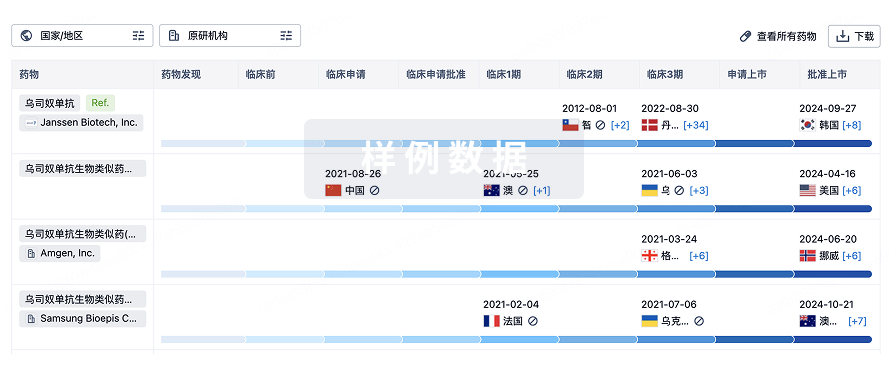预约演示
更新于:2025-05-07
Anti-DLL4 antibody(Regeneron)
更新于:2025-05-07
概要
基本信息
非在研机构- |
权益机构- |
最高研发阶段临床前 |
首次获批日期- |
最高研发阶段(中国)- |
特殊审评- |
关联
100 项与 Anti-DLL4 antibody(Regeneron) 相关的临床结果
登录后查看更多信息
100 项与 Anti-DLL4 antibody(Regeneron) 相关的转化医学
登录后查看更多信息
100 项与 Anti-DLL4 antibody(Regeneron) 相关的专利(医药)
登录后查看更多信息
16
项与 Anti-DLL4 antibody(Regeneron) 相关的文献(医药)2023-06-28·Science Translational Medicine1区 · 医学
Notch signaling drives intestinal graft-versus-host disease in mice and nonhuman primates
1区 · 医学
Article
作者: Hoffman, Michelle ; Furlan, Scott N ; Outen, Riley ; Yu, Alison ; Radtke, Freddy ; Ludewig, Burkhard ; Gerdemann, Ulrike ; Panoskaltsis-Mortari, Angela ; Zheng, Hengqi ; Thurston, Gavin ; Gómez Atria, Daniela ; Hunt, Daniel J ; Colonna, Lucrezia ; Chen, Guoying ; Rui, Xianliang ; Koch, Ute ; Lane, Jennifer ; Vanderbeck, Ashley ; Kean, Leslie S ; Harari, Olivier ; McGuckin, Connor ; Perkey, Eric ; Shimizu, Yoji ; Allman, Anneka ; Kelly, Samantha ; Burbach, Brandon ; Maillard, Ivan ; Kuhnert, Frank ; Tkachev, Victor ; Blazar, Bruce R ; Carpenter, Stephen M
2020-11-01·Advances in Wound Care3区 · 医学
Dll4 Blockade Promotes Angiogenesis in Nonhealing Wounds of Sox7-Deficient Mice
3区 · 医学
Article
作者: Kim, Il-Kug ; Ryu, Junghwa ; Kim, Injune ; Chang, Hak ; Yang, Jee Myung
2019-07-01·Experimental Cell Research3区 · 医学
The bispecific antibody HB-32, blockade of both VEGF and DLL4 shows potent anti-angiogenic activity in vitro and anti-tumor activity in breast cancer xenograft models
3区 · 医学
Article
作者: Wang, Shijing ; Wang, Min ; Wu, Min ; Wen, Hui ; Zhou, Rihong
100 项与 Anti-DLL4 antibody(Regeneron) 相关的药物交易
登录后查看更多信息
研发状态
10 条进展最快的记录, 后查看更多信息
登录
| 适应症 | 最高研发状态 | 国家/地区 | 公司 | 日期 |
|---|---|---|---|---|
| 移植物抗宿主病 | 临床前 | 美国 | 2023-06-28 |
登录后查看更多信息
临床结果
临床结果
适应症
分期
评价
查看全部结果
| 研究 | 分期 | 人群特征 | 评价人数 | 分组 | 结果 | 评价 | 发布日期 |
|---|
No Data | |||||||
登录后查看更多信息
转化医学
使用我们的转化医学数据加速您的研究。
登录
或

药物交易
使用我们的药物交易数据加速您的研究。
登录
或

核心专利
使用我们的核心专利数据促进您的研究。
登录
或

临床分析
紧跟全球注册中心的最新临床试验。
登录
或

批准
利用最新的监管批准信息加速您的研究。
登录
或

生物类似药
生物类似药在不同国家/地区的竞争态势。请注意临床1/2期并入临床2期,临床2/3期并入临床3期
登录
或

特殊审评
只需点击几下即可了解关键药物信息。
登录
或

生物医药百科问答
全新生物医药AI Agent 覆盖科研全链路,让突破性发现快人一步
立即开始免费试用!
智慧芽新药情报库是智慧芽专为生命科学人士构建的基于AI的创新药情报平台,助您全方位提升您的研发与决策效率。
立即开始数据试用!
智慧芽新药库数据也通过智慧芽数据服务平台,以API或者数据包形式对外开放,助您更加充分利用智慧芽新药情报信息。
生物序列数据库
生物药研发创新
免费使用
化学结构数据库
小分子化药研发创新
免费使用
